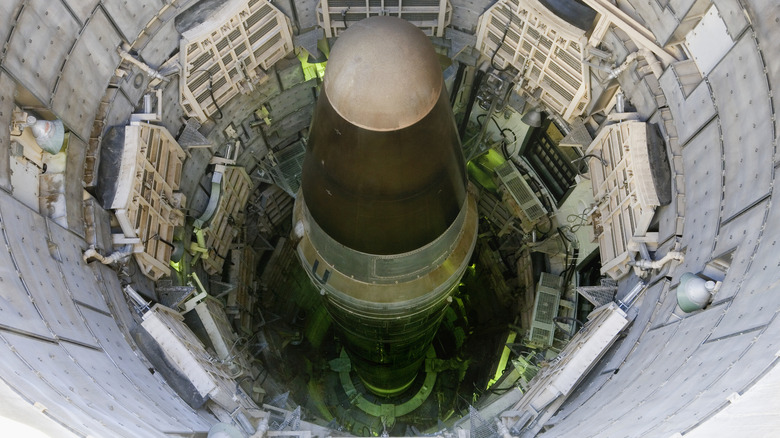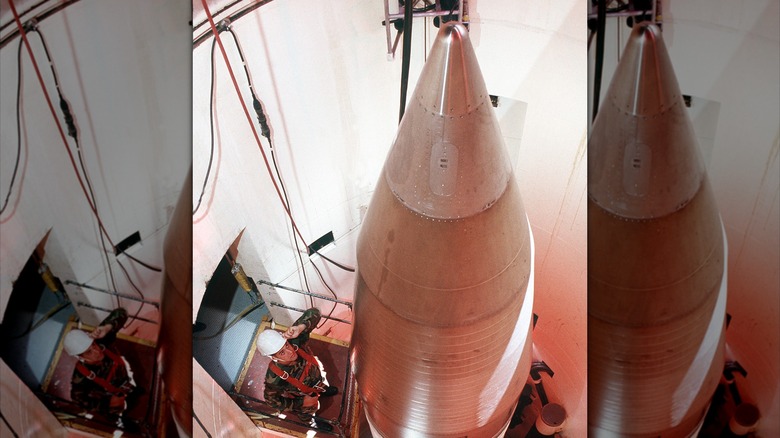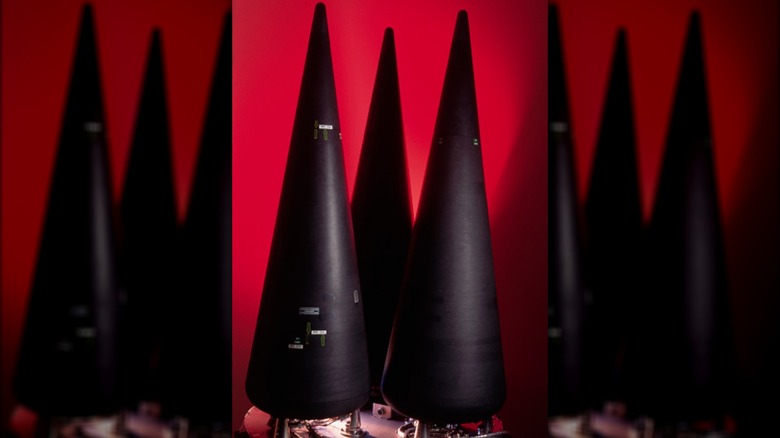Where Are America's Nuclear Missiles Built And Who Makes Them?
The United States has been producing nuclear weapons since the 1940s, and to date, it is the only nation to use them in combat. Initially, nuclear weapons were massive bombs of low yield, but technology improved as time (and the Cold War) passed. Eventually, American nuclear scientists figured out how to make them smaller while also making them significantly more powerful, and these days, there are nukes of all kinds that can be attached to cruise missiles, artillery shells, bombs, intercontinental ballistic missiles (ICBMs), and more.
It's well known that the U.S. has thousands of nuclear weapons, but what isn't entirely clear to the public is how they're made and who manufactures them. After all, there are many types, from the nuclear-equipped missiles aboard the U.S.' Ohio-class nuclear submarines to the approximate 400 LGM-30 Minuteman III ICBMs capable of carrying three W62 Mk. 12 warheads. These elements, and others, make up the U.S. Nuclear Triad, which details the nation's first-strike and retaliatory response initiatives should nuclear war break out across the globe.
As to who makes America's nuclear missiles and where they're manufactured, that's not a simple answer, as multiple agencies are involved. Missile manufacturers aren't necessarily nuclear weapon manufacturers and maintainers, and vice-versa, so ten American companies are involved in the effort. Some companies focus entirely on specific types of warheads, while others manufacture only missiles, and a handful do both. Here's who makes nuclear missiles, who makes the bombs and warheads that arm them, and where they're all produced.
The U.S.' SLBMs and ICBMs
As of 2025, the U.S. uses two types of long-range nuclear missiles in the form of the aforementioned Minuteman III ICBMs, as well as the Trident II submarine-launched ballistic missile (SLBM). These make up the bulk of America's strategic nuclear stockpile, as these weapons can strike anywhere in the world and were principally kept as a deterrent as part of the policy of Mutually Assured Destruction. Multiple defense contractors are involved in various aspects of these missiles' construction.
Alliant Techsystems produces the Trident II's rocket propulsion systems for the Trident and Minuteman missiles out of the Alliant Techsystems, Inc. (ATK) Rocket Center, WV plant. Boeing is also heavily involved, as it covers the maintenance of all Minuteman III missiles in the arsenal. Additionally, Boeing handles flight controls, guidance, secure codes, engineering, and weapons system testing out of multiple locations throughout the U.S. L3Harris' Aerojet Rocketdyne also works on the propulsion systems for both long-range missiles out of its Huntsville, Alabama and Camden, Arkansas locations.
Lockheed Martin is responsible for the construction of the Trident II D5 missile out of its Sunnyvale, California plant. However, it expanded production to a facility in Titusville, Florida, that will go online in 2027. Northrop Grumman also works on maintaining the Minuteman III stockpile at various ICBM silos, so there are several notable organizations constantly working to build and maintain the U.S. nuclear missile stockpile. The same is true of the actual nuclear weapons, which are similarly produced by multiple agencies.
The U.S.' Nuclear Warheads
A nuclear missile doesn't do much without an active warhead attached, and the U.S. has thousands of them. There are numerous types fitted to a variety of missiles, and multiple agencies work to build and maintain them. Babcock & Wilcox and Bechtel are involved in the modernization of the U.S.' nuclear stockpile, which is done out of the National Nuclear Security Administration's (NNSA) Pantex plant in Carson County, Texas, and the Y-12 National Security Complex in Oak Ridge, Tennessee. Bechtel is responsible for monitoring the reliability and safe use of the entire nuclear weapons stockpile, which it does at multiple locations throughout the country.
Honeywell International is responsible for simulating nuclear testing, as real-world testing has been banned since 1963. Additionally, the defense contractor manages the life-extension program for the Trident II. Jacobs Engineering designs, builds, and maintains the infrastructure needed to build nuclear warheads used in both the U.S. and the U.K.'s SLBMs. The NNSA has launched an overall modernization plan, which focuses on producing 50 new uranium pits, the radioactive core of nuclear weapons, at the Savannah River Site, South Carolina, and 30 at the Los Alamos National Laboratory in New Mexico each year.
A new ICBM, the LBM-35A Sentinel, is also being designed by Northrop Grumman alongside the new W87-1, designed at the Lawrence Livermore National Laboratory in Livermore, California, which will sit atop it. There are many components designed, built, and manufactured by other companies spread across the U.S., so nuclear missiles and the weapons that arm them are produced in many places throughout the country. This is unlikely to change, as it's fairly common for the U.S. to not keep all of its weapons design and manufacturing facilities in one basket.


